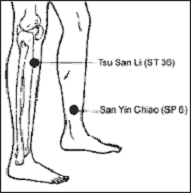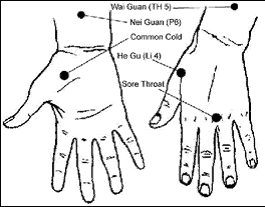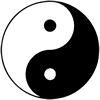
In the following article, Dr. Jake Fratkin gives us an acupuncture protocol to help pass kidney stones during an acute attack. He also, talks of an herbal product that he himself has formulated to treat and prevent kidney stones.
Treating Acute Kidney Stone Attack
BY
Jake Paul Fratkin, OMD
I created AMBER STONE FORMULA as a variation on PASSWAN, a Chinese patent medicine for the treatment of kidney stone from Bai Yun Shan Pharmaceutical Manufactory in Guangzhou. PASSWAN has become generally unavailable in the United States, and few American companies have elected to offer a kidney stone formula. The original name, PASSWAN, I suppose is a Chinese-English variation for Pass (the Stone) Wan (Pill). Its Chinese name is te xiao pai shi wan, which translates as “Specially Effective Expel Stone Pill”. The formula is certainly “Specially Effective.” I have heard of cases of acute stone impaction that would release within 30 minutes of taking the pill.
The Herbal Formula. The original formula had the following composition:
Desmodium Jin Qian Cao 25.0 %
Lygodium Hai Jin Sha 20.0
Angelica Bai Zhi 10.0
Andrographis Chuan Xin Lian 10.0
Achyranthes Niu Xi 7.5
Ficus Wu Zhi Mao Tao 5.5
Rheum Da Huang 5.0
Millettia Niu Da Li 5.0Succinum Hu Po 5.0
Sha Niu * 4.0
Notoginseng Tian Qi 3.0
*(Unknown herb. Translates as Sand Cow, and in fact could be stones or sand from a cow’s bladder or kidney.)
Our formula for Golden Flower is as follows:
Desmodium Jin Qian Cao 15 %
Lygodium Hai Jin Sha 15
Imperata Bai Mao Gen 12
Pyrrosia Shi Wei 12
Lonicera Jin Yin Hua 9
Millettia Ji Xue Teng 8
Notoginseng Sheng Tian Qi 8
Dianthus Qu Mai 7
Succinum Hu Po 7
Talcum Hua Shi 7
The original formula has 11 ingredients, while ours has 10 herbs. Five herbs are the same. The lead herbs are Desmodium Jin Qian Cao and Lygodium Hai Jin Sha. These two herbs together act synergetically to dissolve stone, and offer a significant contribution to the treatment of kidney stone. Western medicine currently employs ultrasound to crack a stone, but this approach shatters the stone into small pieces which injure local tissue as they are expelled. The combination of Jin Qian Cao and Hai Jin Sha actually dissolve the stone, allowing expulsion without damage.
Millettia Ji Xue Teng is a both a blood tonic as well as a blood mover, but in this formula it is included to relax spasm, a chief feature of acute stone obstruction. Notoginseng Sheng Tian Qi helps to stop bleeding. The last shared herb of the formula is Succinum Hu Po, or amber pine resin, which is used synergestically with Desmodium Jin Qian Cao and Lygodium Hai Jin Sha to treat urinary obstruction and dissolve stone.
In my formula, I also added herbs to reduce kidney and bladder damp heat, namely Pyrrosia Shi Wei, Dianthus Qu Mai and Talcum Hua Shi. Damp heat is the underlying condition that allows stones to form in the first place. The heat congeals stones, and it is important to clear heat to address the root cause. These damp heat herbs specifically go to the kidney and bladder.
The final herbs of the formula treat specific aspects of a kidney stone presentation. Imperata Bai Mao Gen reinforces the effect of stop bleeding, and also helps to heal damaged tissue following an acute attack. Lonicera Jin Yin Hua inhibits infection, which often accompanies the damage of a kidney stone.
Read more ›
 In traditional Chinese medicine, the decision making process is dependent on the strong energy of the Gallbladder. When the Gallbladder energy is weak, a person may have trouble making decisions.
In traditional Chinese medicine, the decision making process is dependent on the strong energy of the Gallbladder. When the Gallbladder energy is weak, a person may have trouble making decisions.



 The Lung in Chinese medicine is a yin organ. It is paired with the Large Intestine, a yang organ. The most important function of the Lungs in Chinese medicine is to govern respiration – the inhalation of air, or pure qi. This pure qi inhaled by the Lungs is combined with the food qi extracted from food by the Spleen to produce the “gathering qi” that supports the functioning of the whole body after birth.
The Lung in Chinese medicine is a yin organ. It is paired with the Large Intestine, a yang organ. The most important function of the Lungs in Chinese medicine is to govern respiration – the inhalation of air, or pure qi. This pure qi inhaled by the Lungs is combined with the food qi extracted from food by the Spleen to produce the “gathering qi” that supports the functioning of the whole body after birth. Upper back pain is a condition that I commonly treat in my acupuncture practice. Often this type of pain is related to occupational repetitive motion injuries. Dentists, teachers, hairdressers, and band directors have sought my help in addressing upper back pain. Sometimes this type of upper back pain is associated with a cervical disk nerve impingement that may also cause neck pain and pain radiating to the shoulder and down the arm. Stress related neck and shoulder tension may also be the culprit.
Upper back pain is a condition that I commonly treat in my acupuncture practice. Often this type of pain is related to occupational repetitive motion injuries. Dentists, teachers, hairdressers, and band directors have sought my help in addressing upper back pain. Sometimes this type of upper back pain is associated with a cervical disk nerve impingement that may also cause neck pain and pain radiating to the shoulder and down the arm. Stress related neck and shoulder tension may also be the culprit. A collection of twelve very important acupuncture points called the Back Shu, or Back Transporting points are located on the Bladder meridian along the spine. There is a Back Transporting point for each of the six yin organs and each of the six yang organs. They are called “transporting” points because it is said that they transport “Qi” to the inner organs.
A collection of twelve very important acupuncture points called the Back Shu, or Back Transporting points are located on the Bladder meridian along the spine. There is a Back Transporting point for each of the six yin organs and each of the six yang organs. They are called “transporting” points because it is said that they transport “Qi” to the inner organs. Congee is a thin porridge or gruel most often made from rice. Congees strengthen the Spleen energy and nourish Blood. Congee is very commonly eaten for breakfast in China. Because of the nourishing properties of congee, and the fact that it is very easily digested, congees are often prescribed for elderly or chronically ill patients with weak blood and low energy. Congee made with brown rice is often given to nursing mothers to increase milk supply. The therapeutic properties of congee may be enhanced by adding traditional chinese herbs or other nutritional foods with properties known to address specific health issues.
Congee is a thin porridge or gruel most often made from rice. Congees strengthen the Spleen energy and nourish Blood. Congee is very commonly eaten for breakfast in China. Because of the nourishing properties of congee, and the fact that it is very easily digested, congees are often prescribed for elderly or chronically ill patients with weak blood and low energy. Congee made with brown rice is often given to nursing mothers to increase milk supply. The therapeutic properties of congee may be enhanced by adding traditional chinese herbs or other nutritional foods with properties known to address specific health issues. The Spleen in Chinese medicine is a yin organ. The Spleen is partnered with the Stomach, a yang organ. Together they are responsible for transforming food and drink into Qi and blood during the digestion process.
The Spleen in Chinese medicine is a yin organ. The Spleen is partnered with the Stomach, a yang organ. Together they are responsible for transforming food and drink into Qi and blood during the digestion process. Ginger has been used for centuries in China for both culinary and medicinal purposes. Used in many forms – fresh ginger, dried ginger, ginger tea, ginger juice, or ginger oil – ginger is an important herb in the Chinese diet.
Ginger has been used for centuries in China for both culinary and medicinal purposes. Used in many forms – fresh ginger, dried ginger, ginger tea, ginger juice, or ginger oil – ginger is an important herb in the Chinese diet.


